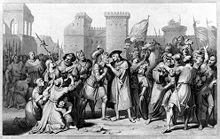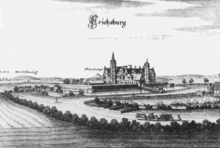Erich I. (Braunschweig-Calenberg-Göttingen)

Erich I., "the elder" (born February 16, 1470 in Neustadt am Rübenberge on the Rovenburg ; † July 30, 1540 in Hagenau / Alsace ) had been Duke of Braunschweig-Lüneburg and ruling Prince of Calenberg-Göttingen since 1495 .
Live and act
origin
Erich is considered to be the founder of the Calenberg line of the House of Braunschweig-Lüneburg, his father Wilhelm II, who died in 1503 , already divided his lands between his sons Heinrich and Erich before his death in 1495 . Erich received the principalities of Calenberg and Göttingen , Heinrich the principality of Braunschweig-Wolfenbüttel . In his youth, Erich traveled to Jerusalem as a pilgrim and toured Italy before he entered the service of Emperor Maximilian .
In the service of the emperor

At a young age, Erich distinguished himself as a brave fighter on the side of the Roman-German king and took part in a campaign against the Turks in 1497. He fought in later wars against Venice, the Swiss Confederation and France. In the Bavarian-Landshut War he saved the life of the future emperor in the Battle of Wenzenbach in 1504 , whereupon he was knighted before him.
Erich I was the second son of Duke Wilhelm II of Braunschweig-Wolfenbüttel († 1503) and received rule over the principality with his brother Duke Heinrich the Elder (1463-1514) in 1491 and 1494, respectively, in the division of the estate with his brother Duke Wilhelm II Calenberg-Göttingen, while his older brother Braunschweig-Wolfenbüttel received. In 1505 the 35-year-old Duke made Neustadt am Rübenberge the second seat of government.
After the Duke's first marriage to the widow of Archduke Sigismund of Austria , Katharina of Saxony , had remained childless, he married the 14-year-old Elisabeth of Brandenburg on July 7, 1525 after her death . The long-awaited successor Erich II (1528–1584) emerged from this marriage . When Elisabeth fell ill in childbirth in 1528, she blamed the witchcraft of her husband's lover, Anna Rumschottel. She forced her husband to go to an inquisition trial . As a result, several women were burned and the duke let the duke escape. However, it was later burned in Hameln.
In the Hildesheim collegiate feud (1519–1523) he conquered Hunnesrück Castle together with Heinrich the Younger of Wolfenbüttel in 1521 . It is located on a hill near what is now the Hunnesrück district of Dassel . He bombarded the castle with heavy artillery from the Hatop ridge. But he gave it up after a short time. About 3 km further east he had the Erichsburg built in a swampy lowland from 1527 to 1530, protected by a wide moat and high ramparts . It was named after his heir, who was born in 1528, later Duke Erich II . Erich I temporarily served it as the official residence. During the construction period he lived in the old Hunnesrück Castle.
After the feud, the office of Koldingen and Poppenburg fell to Duke Erich I according to the provisions of the Quedlinburg Recess . In 1523, the monastery parish of St. Andreas in Derneburg placed itself under the protection of Erich I of Calenberg, because the riders of Duke Heinrich's riders kept looting II. Of Braunschweig-Lüneburg took place.
In 1529 Erich allowed the city of Hanover to hold an annual rifle festival, which today is the largest of its kind in the world as the Hanover Shooting Festival . In 1530, Duke Erich I took possession of Aerzen again for the Guelphs (his coat of arms is above the door in the north wing of the castle).
In 1539 Erich I combined the previous offices of Hunnesrück, Lüthorst and Lauenberg to form the new office of Erichsburg. This existed in its form until 1643.
In 1540, almost 23 years after Martin Luther posted his theses , Duke Erich I of Calenberg-Göttingen died. His son Erich II was still a child, which is why his mother, Duchess Elisabeth, took over government for five years. Two years earlier she had already had the Lord's Supper served in both forms in public in a church service . From then on the marriage was denominational. The duke remained Catholic, the duchess was Lutheran.
Duke Erich I died on July 30, 1540 at the Reichstag in Hagenau. He left behind high debts, which were put at 900,000 thalers , as well as two important buildings: the Erichsburg near Dassel and the Calenberg Castle, which he restored . His burial did not take place until 1541 in the St. Blasiikirche in Münden , after his corpse could be released in Hagenau a year after his death against payment of his debts. For this, each subject of his duchy had to pay 16 pfennigs.
progeny
Duke Erich had a son and three daughters from his second marriage to Elisabeth von Brandenburg:
- Elisabeth (April 8, 1526 - August 19, 1566) ∞ (1543) Count Georg Ernst von Henneberg (1511–1583)
- Erich II , Duke of Braunschweig-Calenberg (* August 10, 1528; † November 17, 1584)
- ∞ (1545–1573) Sidonie von Sachsen (* March 8, 1518; † January 4, 1575), daughter of Heinrich von Sachsen and Katharina von Mecklenburg
- ∞ (1576) Dorothea von Lothringen (* August 24, 1545 - † June 2, 1621), daughter of Francis I of Lothringen and Christina of Denmark
- Anna Maria (* April 23, 1532; † March 20, 1568) ∞ (1550) Albrecht the Elder Ä. , Margrave of Brandenburg-Ansbach, Duke of Prussia (1490–1568)
- Katharina (* 1534; † May 10, 1559) ∞ (1557) Wilhelm von Rosenberg , Oberburggraf of Bohemia (1535–1592)
reception
The place Erichshagen , today part of the city Nienburg / Weser , was named after him. He had founded the settlement near Wölpe Castle, which he had rebuilt as a castle after destruction in the Hildesheim collegiate feud .
literature
- Karl Janicke: Erich I. In: General German Biography (ADB). Volume 6, Duncker & Humblot, Leipzig 1877, p. 203 f.
- Klaus Friedland: Erich I .. In: New German Biography (NDB). Volume 4, Duncker & Humblot, Berlin 1959, ISBN 3-428-00185-0 , p. 584 ( digitized version ).
- Wolfgang Kunze: Duke Erich I of Braunschweig-Lüneburg . In: Wolfgang Kunze (ed.): Life and buildings of Duke Erich II of Braunschweig-Lüneburg. Catalog for the historical exhibition in Landestrost Castle , Neustadt am Rübenberge . Hannover 1993, pp. 31-45.
swell
- ^ History of St. Andreas in Sottrum ( Memento from January 7, 2007 in the Internet Archive ) on September 25, 2006
Web links
- Picture and brief biography of Duke Erichs with his second wife Elisabeth on the official website of the House of Welfs.
- Coins from his reign
- Historical picture of the Erichsburg
| predecessor | Office | successor |
|---|---|---|
| Wilhelm II. |
Prince of Calenberg-Göttingen 1495–1540 |
Eric II. |
| personal data | |
|---|---|
| SURNAME | Erich I. |
| ALTERNATIVE NAMES | Eric the Elder |
| BRIEF DESCRIPTION | Duke of Brunswick-Lüneburg |
| DATE OF BIRTH | February 16, 1470 |
| PLACE OF BIRTH | Neustadt am Rübenberge |
| DATE OF DEATH | July 30, 1540 |
| Place of death | Haguenau |
